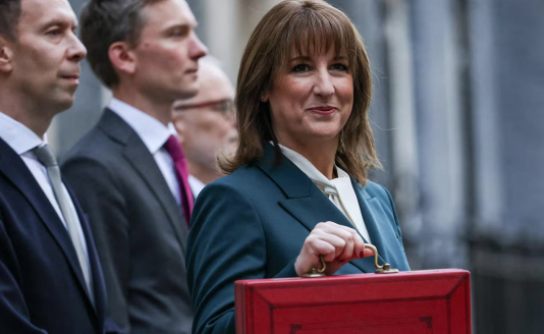27 November 2025
Economic Context and Forecasts by the Office of Budget Responsibility
- UK GDP growth for this year,202, is up from 1.0% at the time of the previous spring forecast to 1.5%.
- However, the OBR has lowered its medium-term productivity outlook by 0.3% to 1.0% by the end of the five-year period.
- The government remains on track to meet its fiscal rules: borrowing is forecast to fall, and public-sector debt (as a share of GDP) is set to decline by 2029–30.
- The government will ‘more than double’ the fiscal headroom against its stability rule to £21.7bn reassuring bond markets.

Budget Overview
To address the challenging forecast, the Chancellor’s strategy is one of fiscal consolidation, introducing substantial tax increases – an additional £26 billion in tax revenue over the next five years, albeit many back-loaded till 2027/28. Spending plans are front-loaded with overall public spending forecast to be £32 billion a year higher in 2029/30 than previously projected. It has left some commentators questioning the direction of the government’s economic strategy. The decisions taken this week mean the government’s the fiscal headroom – the buffer against economic shocks – will nearly double to £22bn by 2029/30.
Headline Budget Announcements
- National Insurance and income tax thresholds will be frozen for an extra three years until April 2031 dragging more people into tax / more paying higher rates.
- Increasing the National Minimum Wage rate (from £10 to £10.86 per hour and the National Living Wage (from £12.21 to £12.71).
- Cap for pension salary sacrifice schemes from 2029 – with contributions above £2,000 subject to tax in the same way as other employee pension contributions.
- Cap of £12,000 a year for Cash Isas from April 2027 for the under-65s. Remaining at £20,000 for over-65s.
- Two-child benefit cap scrapped from April 2026 at a cost of £3bn.
- Properties worth more than £2m charged £2,500 annually and properties worth more than £5m charged £7,500.
- Pay per mile charge for electric vehicles – 3p per mile for electric cars and 1.5p for plug-in hybrids.
- Fuel Duty Frozen until August 2026 and then gradual increased
Headline Business Announcements
- Reduction in business rates for many retail, hospitality and leisure businesses.
- Higher business rates rate for those with rateable values of £500,000 and above
- Training for under-25s on apprenticeships will be made free of cost for SMEs.
- Reforms to Customs Duty relief for low-value imports: relief for goods under £135 is being removed affecting importers, particularly online retailers relying on low-cost imports.
- Stamp Duty holiday for newly listed companies – three-year exemption on newly issued shares.
- Higher Dividend Tax – up by 2% for the basic rate (8.75% to 10.75%) and the higher rate (33.75% to 35.75%). The additional rate remains unchanged.
- Enterprise Management Incentive - increasing the company eligibility limits for the Enterprise Management Incentives scheme (EMI) to allow scale-ups to join start-ups in offering tax-advantaged shares
- Lower Writing Down Allowance for business investments from 18% to 14% – meaning businesses can’t deduct as much of their investment costs from profits as before. However, as most businesses would claim full expensing this is unlikely to have a material impact
- Writing Down Allowance (1st year) - from 1st Jan 2026 the government will introduce a new first-year allowance of 40% for main‑rate assets. Cars, second-hand assets and assets for leasing overseas will not be eligible.
- Employee Ownership Trusts - The government will reduce the relief available on these disposals from 100% of the gain to 50%.
- Consultation on enabling mayoral regions to introduce a tourism tax in England.
For further analysis, links to key documents, please click to our Public Affairs webpage.
Photo credit: REUTERS/Isabel Infantes

